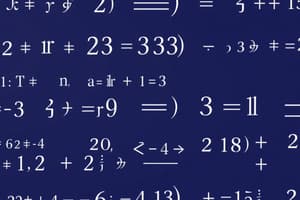Podcast
Questions and Answers
What is a key characteristic of mathematical expressions?
What is a key characteristic of mathematical expressions?
- They use symbols to represent mathematical objects but do not express complete thoughts. (correct)
- They can only represent operations involving only numbers.
- They require a context to be understood completely.
- They state complete thoughts and can be true or false.
Which mathematical operation can be expressed using a symbol?
Which mathematical operation can be expressed using a symbol?
- Addition (correct)
- Conjunction
- Inflection
- Combination
Why is concise mathematical language beneficial?
Why is concise mathematical language beneficial?
- It simplifies communication and reduces the risk of misinformation. (correct)
- It allows more room for ambiguity.
- It requires more background information to interpret.
- It complicates the process of understanding mathematical concepts.
What does understanding the language of mathematics primarily empower students to do?
What does understanding the language of mathematics primarily empower students to do?
Which of the following best describes the function of mathematical operations?
Which of the following best describes the function of mathematical operations?
Which of the following statements about mathematical sentences is correct?
Which of the following statements about mathematical sentences is correct?
What is indicated by the expression 𝑏 < 𝑔?
What is indicated by the expression 𝑏 < 𝑔?
Which statement accurately reflects the relationship between mathematical symbols and words?
Which statement accurately reflects the relationship between mathematical symbols and words?
What key characteristic distinguishes mathematical language from everyday language?
What key characteristic distinguishes mathematical language from everyday language?
Which of the following best describes a binary operation?
Which of the following best describes a binary operation?
Which of the following is NOT typically classified as a logical connective?
Which of the following is NOT typically classified as a logical connective?
How can sets be described or written?
How can sets be described or written?
What is the primary goal of learning mathematical language and symbols?
What is the primary goal of learning mathematical language and symbols?
In mathematical statements, what is the role of precision?
In mathematical statements, what is the role of precision?
Which operation is NOT typically classified as one of the five operations on sets?
Which operation is NOT typically classified as one of the five operations on sets?
Mathematics is often called a language because it:
Mathematics is often called a language because it:
Which variable expression represents 'The sum of the cube of a number and four'?
Which variable expression represents 'The sum of the cube of a number and four'?
What variable expression is equivalent to 'Six subtracted from a number'?
What variable expression is equivalent to 'Six subtracted from a number'?
Which expression correctly represents 'The product of six and twice a number'?
Which expression correctly represents 'The product of six and twice a number'?
Which variable expression corresponds to 'The square of the sum of a number and eleven'?
Which variable expression corresponds to 'The square of the sum of a number and eleven'?
Which expression represents 'A number increased by four'?
Which expression represents 'A number increased by four'?
What is the variable expression for 'One half of a number'?
What is the variable expression for 'One half of a number'?
Which expression represents 'The quotient of 12 and a number'?
Which expression represents 'The quotient of 12 and a number'?
Which variable expression reflects 'Three less than a number'?
Which variable expression reflects 'Three less than a number'?
Identify the expression that corresponds to 'The difference of x and y'.
Identify the expression that corresponds to 'The difference of x and y'.
What variable expression indicates 'Twice a number'?
What variable expression indicates 'Twice a number'?
What variable can be used to represent the smaller of two consecutive odd integers?
What variable can be used to represent the smaller of two consecutive odd integers?
If the units digit of a two-digit number is represented by $x$, how is the tens digit expressed?
If the units digit of a two-digit number is represented by $x$, how is the tens digit expressed?
When expressing the length of a rectangle in terms of its width, which equation is correct?
When expressing the length of a rectangle in terms of its width, which equation is correct?
Which of the following is an example of a closed mathematical sentence?
Which of the following is an example of a closed mathematical sentence?
How are open sentences characterized in mathematics?
How are open sentences characterized in mathematics?
What relationship does an inequality statement express?
What relationship does an inequality statement express?
In the equation $2x - 18 = 6y + 1$, what is the relationship between $x$ and $y$?
In the equation $2x - 18 = 6y + 1$, what is the relationship between $x$ and $y$?
What does the expression $ ext{x - 2 = x + 2}$ represent?
What does the expression $ ext{x - 2 = x + 2}$ represent?
Which method for describing a set involves listing its elements within braces?
Which method for describing a set involves listing its elements within braces?
What does the notation |A| represent in set theory?
What does the notation |A| represent in set theory?
If set A = {a, b, c, d} and set B = {a, b, c, d, e}, which statement is true?
If set A = {a, b, c, d} and set B = {a, b, c, d, e}, which statement is true?
How can the elements in a set be arranged?
How can the elements in a set be arranged?
Which of the following is true regarding the notation x ∈ A?
Which of the following is true regarding the notation x ∈ A?
What is a subset in set theory?
What is a subset in set theory?
When are two sets considered equal?
When are two sets considered equal?
What does the notation A ⊄ B imply?
What does the notation A ⊄ B imply?
Flashcards are hidden until you start studying
Study Notes
Mathematical Language and Symbols Overview
- Mathematics utilizes a distinct language for communicating ideas and concepts.
- Understanding mathematical language and symbols is essential for problem-solving.
Objectives of the Module
- Discuss mathematical language, symbols, and conventions.
- Explain the nature of mathematics as a language.
- Correctly perform operations on mathematical expressions.
- Recognize mathematics as a useful language.
Characteristics of Mathematical Language
- Precise: Each expression has a specific meaning, e.g., ( b < g ) simplifies "The number of boys in a class is less than the number of girls."
- Concise: Mathematical language is brief, e.g., "Three plus eight equals eleven" becomes ( 3 + 8 = 11 ).
- Powerful: Mastering mathematical language empowers students in problem-solving and reasoning.
Expressions vs. Sentences
- Expressions: Combinations of symbols that do not convey complete thoughts, e.g., ( 10 + 13 ).
- Sentences: Complete thoughts represented by symbols, often in the form of equations or inequalities.
Mathematical Operations
- Addition: Add, increased by, sum.
- Subtraction: Subtract, decreased by, difference.
- Multiplication: Multiply, product, times.
- Division: Divide, quotient, shared.
Constructing Mathematical Expressions
- Translate verbal phrases into variable expressions for simplification, e.g., "The sum of a number and ten" becomes ( x + 10 ).
Mathematical Sentences
- Mathematical sentences indicate relationships between expressions using symbols such as equalities and inequalities.
Basic Mathematical Concepts
- Sets: A collection of elements, can be numbers, letters, or other objects.
- Methods to Describe Sets:
- Roster Method: Listing elements in braces, e.g., ( A = {a, b, c} ).
- Rule Method: Describing the set using a property, e.g., ( A = {x | x \text{ is a vowel}} ).
Set Notation
- Cardinal Number: The count of elements in a set, denoted as ( |A| ).
- Membership notations: ( x \in A ) means ( x ) is a member of set ( A ); ( x \notin A ) indicates otherwise.
- Subsets: ( A \subset B ) if all elements of ( A ) are in ( B ); ( A \nsubseteq B ) otherwise.
Importance of Understanding Mathematical Language
- Mastery encourages coherent communication of mathematical thoughts.
- Essential for efficient problem solving and logical reasoning.
Studying That Suits You
Use AI to generate personalized quizzes and flashcards to suit your learning preferences.




